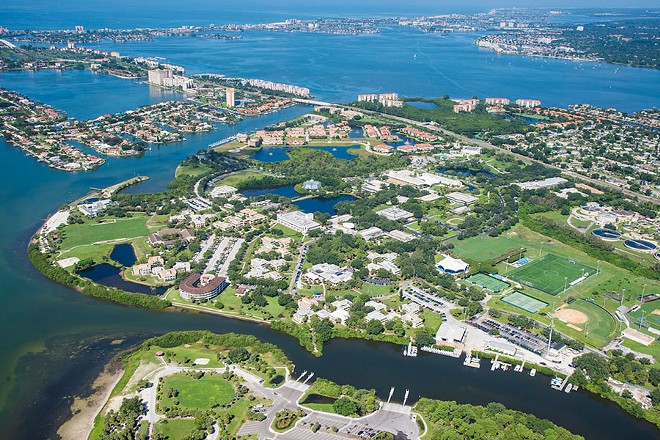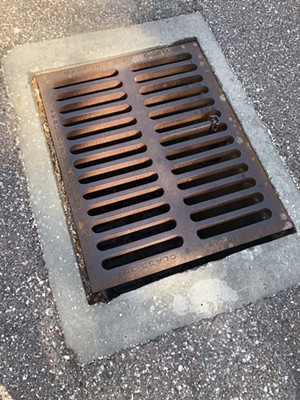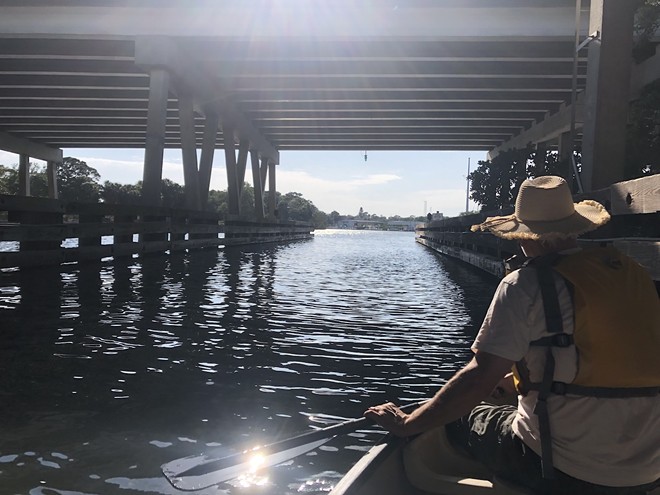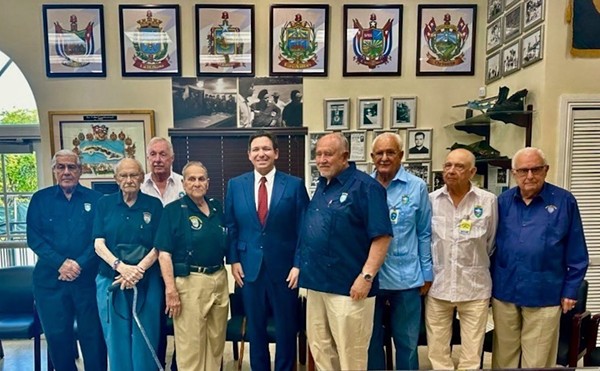I find my friend Tom waiting under a palm tree, wearing a big straw hat that I immediately envy. We’ve decided to explore the creek before us—Frenchman’s Creek—for the column we share on Tampa Bay’s forgotten waterways (#Creekshed). Though paddling urban streams in search of their stories is something we’ve come to enjoy, I’m especially excited to explore Frenchman’s, which I consider a neighbor. For eight years, I’ve worked alongside the creek at Eckerd College. At least twice, I’ve kayaked with the doughty students from Eckerd’s Waterfront out past the mouth of the creek and into the nearby Pinellas National Wildlife Refuge. And, more times than I can count, I’ve sped over the bridge that vaults across the creek just to the east of campus on my way toward the Sunshine Skyway Bridge. But today, we’re going to try and find its source.
This could be harder than it sounds: on the map, Frenchman’s looks less like a creek than a narrow hook of water that snakes between the western edge of campus and the eastern point of Maximo Park, intersected by the I-275 as it plunges south towards the big bridge’s causeway. On the far side of the Interstate, it transforms into a maze of blue-brown ponds and marinas, woven into the gray-green patchwork of residential blocks around it. A creek in camouflage.
As we unload my old canoe, and prepare to launch, Tom takes in the scene with a sweep of his well-shaded head: downstream, the creek curves through walls of mangrove, then opens out to Boca Ciega Bay. Upstream, in the direction we’ll be heading, it narrows into the I-275 underpass. Over the concrete barrier, we can see the tops of cars and trucks—an estimated 50,000 of them every day—that fly right over the creek. Blink and you’d miss it. “This place is so marginal!” Tom exclaims.
I think I know what he means. For decades, Frenchman’s Creek has been more of a corridor than a creek. It’s a convenient passage to link boaters to the open water of Boca Ciega Bay (as witnessed by the steady stream of party boats and fishing launches we notice around us). Until the 1970s it served as a discharge point for the nearby water treatment plant, and it is still prone to outbreaks of fecal coliform during the rainy summer months (Eckerd students call this a “poonami”). Even the “Frenchman” for whom it is named—a Quebecois named Alfred Lechevalier—used the stream as an access point for stalking its rich rookeries to supply the plume trade in the 1880s, leaving behind a decimated wading bird population.

So that’s what we’re paddling toward: an 11-acre impoundment at the end of this half-mile of marginal urban waterway. But even if we make it, I’m not sure we’ll find the source.
Months ago, I had stood (perhaps not perfectly legally) on the far shore of that same pond, trying not to look too suspicious as I took a pair of binoculars out of my pocket. An August downpour fell in gleaming curtains all around me, whipping the water’s brown surface into silver. Muscovy ducks were reveling in the new geography of rivers and swales that had formed on the parking lot and lawns of the apartment complex. Shoes soaked and rain jacket clammy against my skin, I focused the glasses on the distant fringe of cattails where the pond, I thought, must connect to the Frenchman’s creek. But I couldn’t spot the outlet. How did the water get from here to there?
And where, I wondered, looking at the submerged lawns around me, will all of this water go?
Back in the canoe, we pass an abandoned shack advertising “LIVE BAIT,” floating halfway back into the mangroves. We paddle toward the highway underpass, where wooden barriers channel boats through the deepest part of the stream, passing an IDLE SPEED sign. It’s hard to square the roar of cars barreling down the Interstate overhead with our quiet passage below. We fall silent, under the spell of the sound.Searching for the source of Frenchman’s Creek is, in a way, trying to peel back some of this history, tuning in to the earlier pulse of the stream.
tweet this
This place could look very different now. In the 1940s, the city of St. Petersburg began imagining how it might use this ragged end of the Pinellas peninsula, known mostly as a “best bet” for local anglers, as a bridge into its future. Real estate developers were rapidly dredging new “finger islands”—those long, backbone-shaped neighborhoods that allow every home to have a waterfront view—out of the bay, hardening up the shoreline with seawalls. Roads needed to catch up, and the city considered multiple proposals for a new Bayway project that would have to pass through Frenchman’s creek. One would have launched from the mouth of Frenchman’s Creek across the shallow bay water to Indian Key and south toward the Don CeSar, creating a chain of spoil islands and residential neighborhoods where there are now mostly mangroves, wading birds, and fiddler crabs.
But plans for the Bayway turned westward, and Frenchman’s creek remained, for a time, in the care of Anna and Captain Leo Davis, who settled along the creek in 1938. Together, the Davises dredged and widened the creek to establish the Izaak Walton Fishing Camp, which would become a legendary spot among local anglers, in 1947. Described as “a familiar and energetic figure in dungarees,” Anna ran the place on her own after Leo died in 1951, right up until the city began construction on the Eckerd College campus in 1959.
The place is still quiet, if not so rustic anymore. Emerging from the underpass, we find ourselves paddling along a bright avenue of boats with names like “Fueling Around” and “Liquid Asset.” A massive boathouse looms up, right next to a glass-fronted sales office. On the south side, blocks of expensive condos, each with its own boat slip, dominate the horizon.

Based on the map, the outlet we’re seeking should be near the southern end of this basin, so we hang right, plunging into a steep-sided canyon of condos and docks. We pass a few friendly dog walkers strolling along the sidewalk above, folks sunning on small but well-appointed porches. No outlet, though; the closest we seem to get are a few narrow, water-stained culverts that peek up over the waterline along the wall that separates us from the lake.
Tom spots a ladder leading up the seawall to the neighborhood above and suggests we give it a try. We tie off the boat, assisted by a friendly mangrove crab who pops out of a nearby culvert, and clamber up, still wearing our bulky life preservers. We follow the sidewalk to the top of the berm that seems to separate the lake from the marina, inspect the shoreline. A thick fringe of head-high cattails lines the near edge of the pond—often a sign of a disturbed waterscape. A little further on, cormorants dive and surface in the lake, or rest on the branches of a spreading oak near the shore.
“Do you think that could be it?” I ask, looking at a spot maybe 60 feet from where we stand, where the water seems to have some extra movement, maybe a pulse, though maybe it’s just the wind pushing the water along. It’s hard not to think of the spectacular turquoise springs up north, the ones that boil where they surge out of a limestone basin, and push you backward with the strength of their current. But I’m not sure if what I’m seeing now is actually a spring; the flows and forces here are a lot less obvious.
What we do find are a couple of storm drains along the berm, dark water glimmering below like stars in a distant universe several feet under the street. Maybe this is the closest we’ll get to an answer: a hidden network of pipes that regulates the flow of the freshwater creek to the salty bay. A miracle of modern plumbing that separated water from muck, made dry land out of a marsh. At least for now.

But something doesn’t sit right. As we settle back into the boat—after a somewhat tricky jump off the end of the ladder—I find myself dwelling on the other kind of connectivity, the one that ecologists used to describe the movement of species and the flow of natural processes across a landscape. For all that we’ve gained in ways to live by the water—seawalls that perch us right on the edge, finger islands that maximize the view, and astounding bridges that help us leap across the bay—we’ve sold the generational wealth of seagrass and mangrove habitats, choked the delicate exchange of currents, sediment, and nutrients that keeps the bay healthy.
It’s so easy to appreciate the beauty of a waterscape without also understanding or honoring water’s complex, life-giving desire to flow. And even as we’re learning new ways to heal the damage we’ve done—living shorelines, artificial oyster reefs, fertilizer bans—we seem to be facing bigger consequences than ever.
That’s when I notice the ripples. First far ahead, then off to our left, the waters bubble and roll as if beginning to boil. A dark hump breaks the surface about 50 feet ahead of us. “Marine life!” I yell, half thrilled and half terrified. A gray snout with two wide nostrils huffs out of the water on our right.
“Manatees!” cries Tom. Lots of manatees! They swim and surface and sigh in a wide kettle all around, their massive bodies dimly drifting beneath the boat. We watch, amazed. Their backs, when they appear, are green with algae, their tail flippers waving like gentle fans. We wonder what their skin might feel like—a mossy old catcher’s mitt?
We also wonder what brings them here, where the sea grass is scant and the hard sides of the marina are lined with keels and propellers. Is it the taste of fresh water, the last detectable pull of the old springs? I want to believe it is. Later on, when I ask a biologist friend, he has a different explanation: “My first thought is a breeding group, one female in estrus and a bunch of males. Only two things would make a male manatee subject itself to any sort of effort: food or girls.”
We know the headlines: manatees are declining fast, victims of habitat loss and harmful algal blooms. Calving just once every two to five years, it’s hard for their population to keep up with the pressures our own population growth places upon them. In such times, what right do we have to the unadulterated joy we’re feeling as we watch them swim around us?
And yet, as we paddle back to Maximo, we can’t stop talking about the extraordinary thing we’ve seen. “An embarrassment,” says Tom, “of riches.” A miracle in a marginal place.
We didn’t find the spring, I think, as we load up the canoe, but we did find a connection: astonishing evidence of life’s desire to endure (ahem, manatee sex party). Even in places where we’ve choked it back.
I wonder what other amazing things we’ll see as we learn to restore the flow.

















